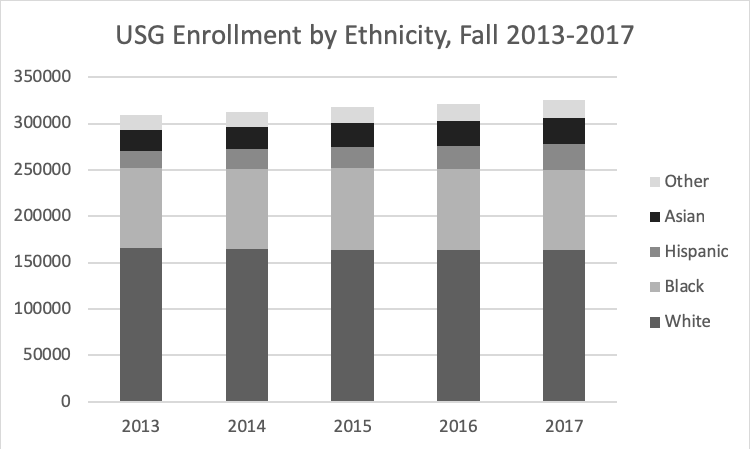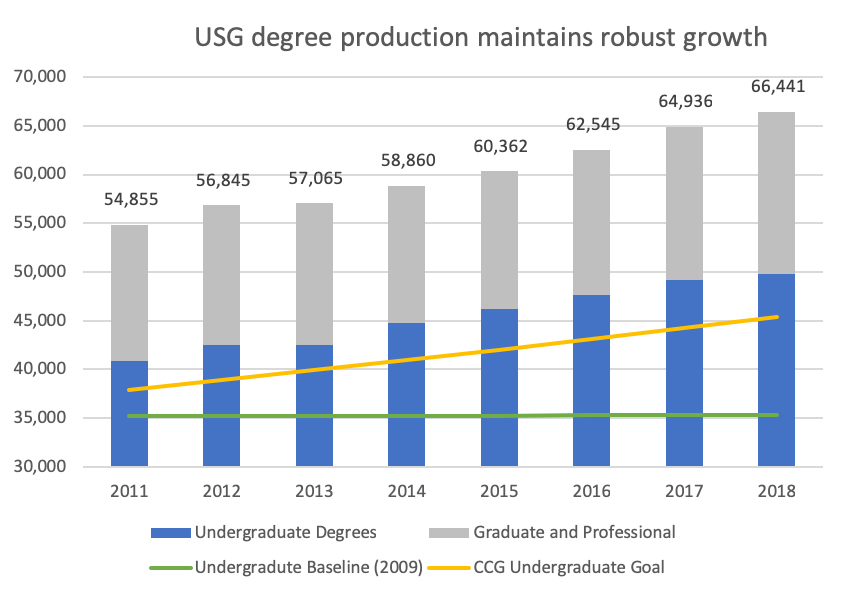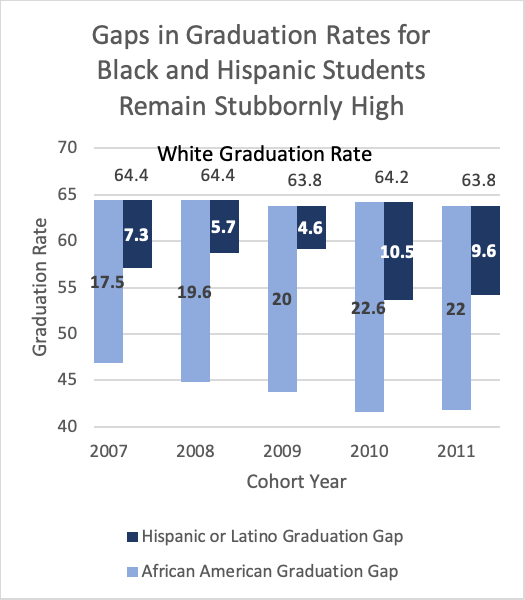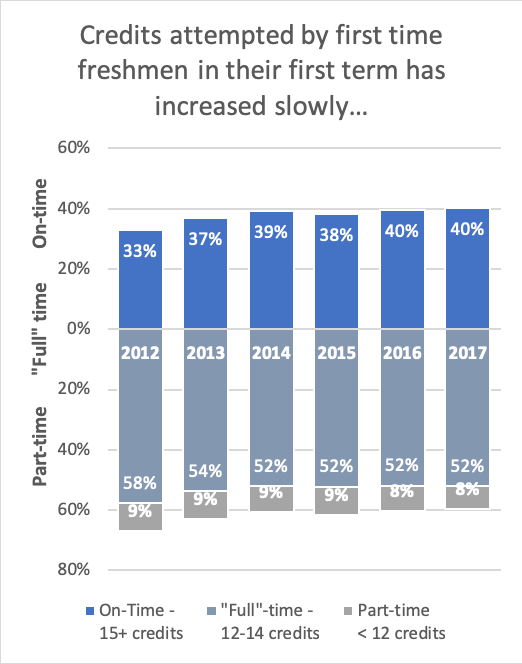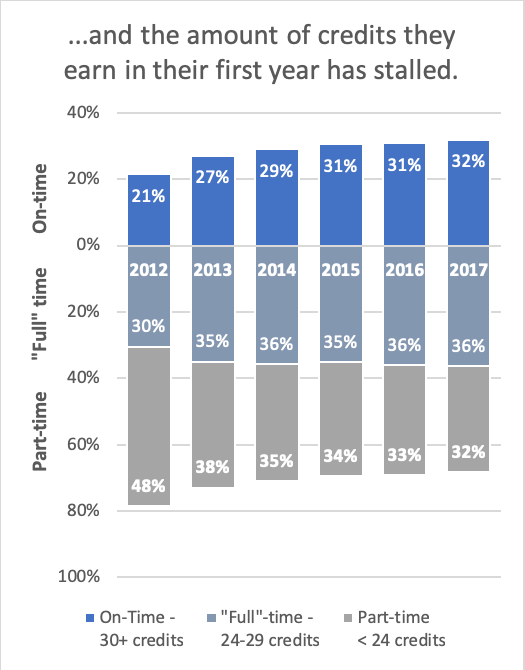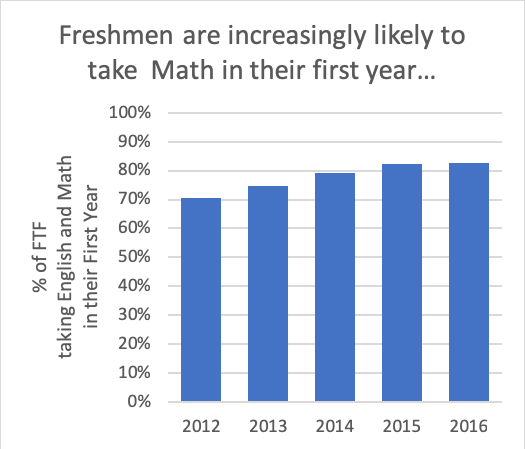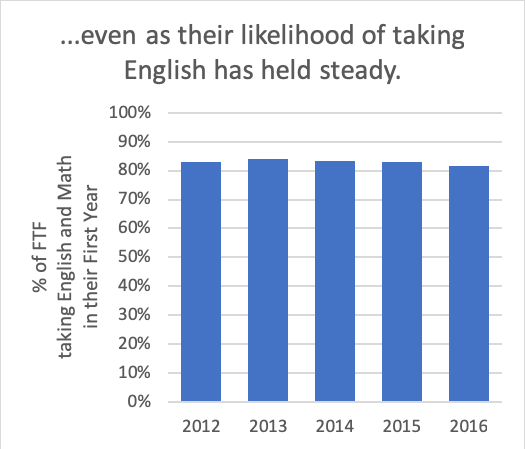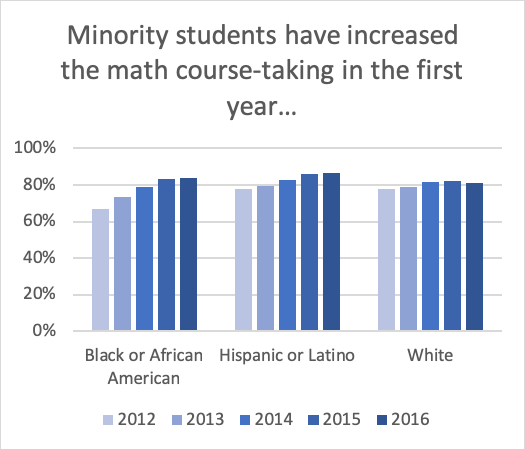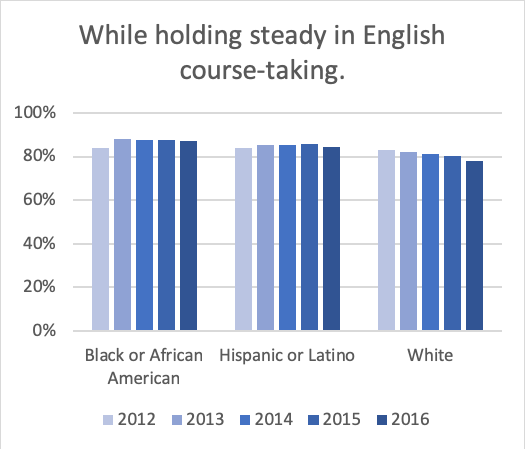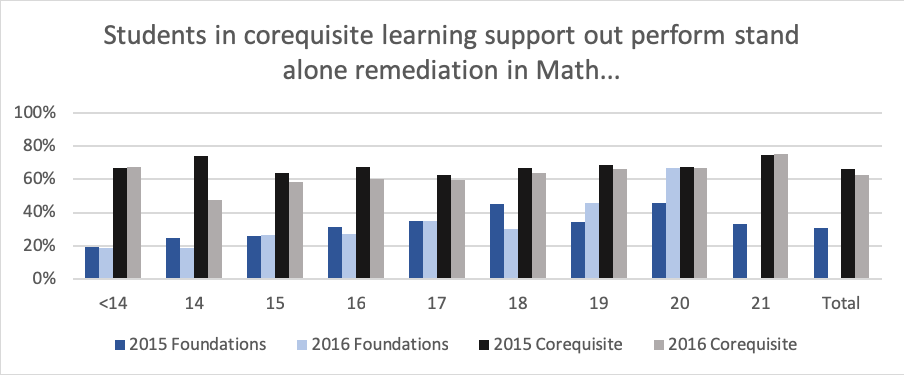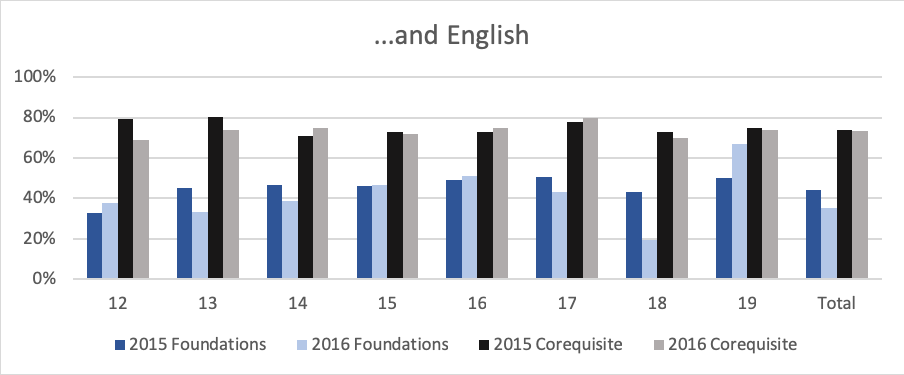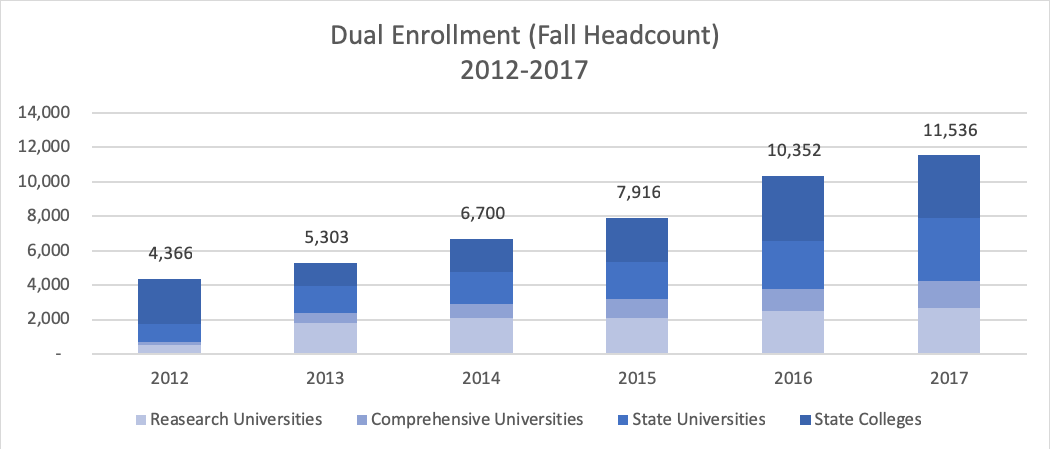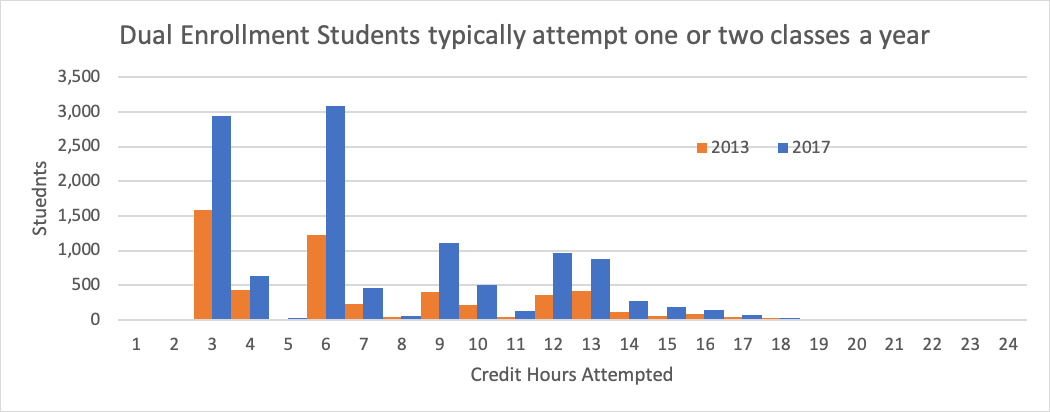University System of Georgia Campus Plan Update 2018
System Overview
In 2011, Governor Nathan Deal announced the Complete College Georgia initiative, a collaborative effort among Georgia’s K-12 schools, public colleges, universities and technical colleges, and the private sector to take concrete steps to improve college access and completion in the state. Framed on a set of high impact strategies organized around nine goals, the initiative builds on national research and local activities to support student success at all levels. The overarching goal is to graduate an additional 250,000 Georgia students with high-quality degrees or certificates by 2025 in order to reach projections of employment readiness. In 2011, each institution in the University System of Georgia and Technical College System of Georgia created action plans on the policies and procedures that they could implement to have the greatest impact on college completion within their institutional mission and context.
Complete College Georgia (CCG) has developed into a framework for focusing institutional attention on what matters most: helping Georgia’s students succeed. Institutions have adopted, adapted, and promoted a wide range of strategies to suit their local settings. More importantly, the work of promoting student success has become much more broadly shared on campus and better understood across the units of institutions. Forging partnerships among functional areas and fostering understandings of how the various elements of a college or university come together for students have helped to support Georgia’s orientation toward building a 21st century workforce.
System Profile
The University System of Georgia (USG) includes 26 institutions, with fall 2017 enrollment of 328,712 students. Academic year 2017 marked the third consecutive year that enrollment in the University System has exceeded the recession peak (fall 2011—318,027) and is an increase of 3,509 or roughly 1 percent, over fall 2016. The increase in enrollment at USG institutions compares favorably with national trends, with four-year public institutions nationally experiencing a very slight (-0.2 percent) drop in enrollment in the past year.
The University System’s institutions in fall 2017 headcount ranged from 2,501 at Atlanta Metropolitan State College to 51,562 at Georgia State University. Georgia Tech witnessed the greatest percentage increase in enrollment in 2016 at 9.4 percent, followed by the College of Coastal Georgia at 3.8 percent and Augusta University at 3.4. Abraham Baldwin Agricultural College saw the greatest decline in enrollment in 2016, dropping 13.5 percent, followed by Savannah State University and Atlanta Metropolitan State College, which shrank by roughly 10 percent. Nearly 84.7 percent of students served by USG institutions are from Georgia, with nearly 10 percent of students from out of state, and just over 5 percent of enrollment consisting of international students. The USG serves a diverse population:
» 50.2 percent white » 26.7 percent Black
» 8.9 percent Asian » 8.4 percent Hispanic
» 5.8 percent other categories/unreported
Over the past five years, the number of Hispanic students has increased by 43 percent and the percentage of Asian students has increased by 28 percent. Black or African American enrollment increased by roughly 1 percent and white enrollment declined by under 2 percent over this same period. Figure 1 illustrates the shifting composition of students enrolled in USG institutions.
Complete College Georgia launched in 2011 with a commitment to increasing the educational attainment of Georgians and a specific goal of increasing the percentage of young adults aged 25-34 with a credential of economic value from 40 percent to 60 percent by 2025. In partnership with the Technical College System of Georgia, private colleges and universities in the state and the state’s K-12 system, Complete College Georgia has begun to narrow the gap between that ambitious goal and the attainment of the young adult population. As of 2017, nearly 49 percent of the young adult population—almost 700,000 people--has a credential of economic value (certificate leading to licensure or an associate degree or higher). Since 2011, the state has added 104,000 credentials over baseline projections and remains on track to meet the goal of an additional 250,000 credentials by 2025. The University System’s contribution to this growth has been substantial, with undergraduate degree conferrals rising increasing by 20 percent since 2011 (from 40,867 to 49,190). The figure below illustrates this trend.
For all this success, however, the state still have a substantial way to go. Significant gaps in attainment, retention, and graduation exist between African Americans and Hispanics and the white population. While African American and Hispanic are an increasingly larger share of the younger population in the state, they remain underrepresented in attainment data. There exists an 11 percentage point gap between the share of the population with an associate degree or higher for the African American and the white population aged 25 and over, and a 21 percentage point gap with Hispanics. This gap is echoed in USG graduation rate gaps, with African American six-year graduation rates systemwide lagging 22 percentage points (41.8 percent to 63.8 percent for the 2011 cohort), and Hispanic rates lagging by 9.6 percentage points (54.2 percent to 63.8 percent).
Across the system, greater than 90 percent of first-time freshmen enroll full-time in their studies. While federal financial aid rules require students to take 12 credits a term in order to be considered full time, the practical math of earning the credits require for an undergraduate degree demands either 15 credits per fall and spring term, or a pattern of continuous enrollment (fall-spring-summer) that amounts to 30 credits per year. Getting off to a strong start with respect to credit taking has benefits for students in terms of on time graduation and overall success. After a period of increasing credit-taking among first time students, progress in this area has stalled somewhat. Across much of the System, credit intensity activity has been the subject of marketing campaigns to encourage on-time course scheduling, with a subset of institutions engaging in more structural scheduling practices to default students into on-time schedules in their first term. The limited progress on this indicator likely reflects the upper bound for marketing and communications campaigns.
The 2017-2018 Academic year saw a wholesale reframing of the work of Complete College Georgia, with a deep focus on reimagining the first year for students. This work integrates many of the features that have been at the core of the CCG work across the System since the beginning—guided pathways to success, program maps, academic advising, transforming remediation, credit intensity, and instructional innovation and excellence—and provides a coherent framework for knitting these efforts together into a comprehensive and structured system of supports for students at the beginning of their academic careers that aids their persistence through to graduation.
Completion Goals, High Impact Strategies and Activities
Ongoing work
Momentum Year
In Summer 2017, the University System began to reframe much of the ongoing CCG work in terms of Momentum, combining core elements from the System’s strategic work with new data-focused components to support student success in the first year. The Momentum Year is a three part approach to the beginning of a student’s first year. Evidence-based research confirms that college students are most successful when they start out their college careers by making a purposeful choice in a focus area or program of study, enter with a productive academic mindset, and follow clearly sequenced program maps that include core English and math, nine credits in the student’s academic area of interest, and 30 credits.
This concept was first introduced at the 2017 Advising Academy in October and supported by an inventory of current activities at institutions during the winter of 2017-2018. In February 2018, all 26 institutions convened cabinet-level leadership teams over two days for a Summit with a dozen national experts to develop a plan for their institution on how they would implement the full scope of the Momentum Year for all students by Fall 2019. Plan development was supported in advance through direct consultation with each campus and follow up visits and discussions at select institutions. Throughout the 2017-2018 year, System staff have worked closely with campus teams to build support for the Momentum Approach, understand the context for the work at the institution level, and help guide implementation and reporting to support this work.
In January, 2018, the University System was awarded one of four grants from Strong Start to Finish to support the development and implementation of the Momentum Year. The Strong Start grant combines the technical expertise of national partners including the Charles A. Dana Center at the University of Texas, the Community College Research Center at Columbia University, Complete College America, Motivate Lab at the University of Virginia, and the John N. Gardner Institute to facilitate reforms across the system. Georgia is one of only four states (out of 47 applicants) to be recognized by the Strong Start initiative, and the only awardee to be conducting a comprehensive system reimagining of the first year.
Advising and Purposeful Choice
Key to students making a purposeful choice and their development of a personal program map are academic advisors, both faculty and staff, who engage in learning and conversations with students to identify their interests, skills, and goals. Advising is the critical point of contact between students and the institution. Robust advising systems can take many forms, including “all professional,” “all faculty,” and “blended advising.” Advisors connect students with the often complex structure and policies of higher education, and are especially critical for the success of first generation, low income, and adult learners for whom college poses special challenges.
A focus in the past year was on strengthening the network of advisors in the state through the Regents Advisory Committee on Academic Advising, which provides a forum for sharing resources and practices across the system, as well as improving the degree to which advising integrates the academic, business, financial aid, and student affairs functions of institutions. Because advisors are often default points of contact for students in need across a wide range of challenges, the role advisors play on campuses is highly cross-functional and crucial to helping students, most especially new students, navigate policies and procedures at their institution.
By having intentional conversations with students during their transition period to college, including pre-orientation, summer orientation, and registration for courses, advisors help students become informed of their options for programs of study or academic focus areas, can assist in their discernment of their fit both academically and personally with their choice, and finally support them in affirming their choice through the selection of an appropriate set of courses for their first (and subsequent) term.
Program Maps & Math Pathways
Program maps are tools to help students better understand their path to a degree. Structured as semester-by-semester outlines of the courses a student must take in a program of study, maps feature a logical sequence of courses that, if a student stays on the map, will get them to graduation on time. Maps include the appropriate, aligned math course and first English course in the first term, an exploration of the discipline and restrict student elective choices to those that will support or expose them beneficially to skills needed in their chosen field.
Twenty one institutions across the system report having program maps for their students for each academic program, nine of which have at least three courses in a discipline included in the map to expose students to their discipline. These maps are also useful in predicting course loads and helping to relieving course availability bottlenecks to improve student on-time completion and lower credits at graduation.
Optimally, program maps offer students an overview of the expectations and demands of a particular degree program; indicate clear, term-by-term guidance for the courses they must take and when, outlining any prerequisites along the way, and offer recommendations for electives from outside the program that complement or support courses from within the discipline. Maps should be designed so that students complete their first math and English courses and three courses in their identified field in their first year, and include a minimum of 30 credits. In the system, all institutions with program maps meet the English and math design recommendations, and more than half include three courses in the area of academic focus.
An additional imperative from the recent year has been to align gateway math courses with the program of study. Extensive work by the Academic Advisory Committee on Mathematical Subjects resulted in a recommendation that students pursuing programs that do not include some Calculus be encouraged to pursue either Quantitative Reasoning or Math Modeling rather than College Algebra. Both of these options include appropriate levels of algebra, but provide a more appropriate foundation for students whose academic pathways lead toward statistics rather than Calculus.
In 2018, the full scaling of corequisite learning support (see next section) changed the placement eligibility for a student’s first math class, raising the floor for students to place into College Algebra. As this change is implemented, it is anticipated that there will be an increase in students being placed into non-College Algebra math courses, underscoring the alignment with programs and improving the definition of these pathways. Aligned math pathways were affirmed by the disciplinary advisory groups in 2017 and posted to the CCG website as a point of reference.
English and Math in the First Year
Student transcript analysis reveals the central role that core English and math play in overall student success. This is in part true because all students must complete these courses within their first 30 credits, but the outsized influence of these courses also reflect their function at the center of the curriculum as courses that directly shape academic analysis, inquiry and communications for students as they make the transition to college work. Over the past 10 years, the graduation rate for students who pass both of these courses averages about 66 percent, while that or those who pass neither is only 8 percent. Student passing either Math or English only in their first term have 41 percent and 37 percent chances of graduating (respectively). Historically the rate of students passing both in their first year has been only 50 percent. In recent years, with the broader rollout of program maps and corequisite learning support, the share of student who take either English and Math in their first year is above 80 percent for either. This trend holds true across racial and ethnic groups, with in excess of 80 percent of Black and Hispanic students likely to take either English or Math in their first year.
Corequisite Learning Support
As noted, in 2017 the University System announced that after three years of evidence of substantial success in corequisite learning support across all levels of preparation, stand-along “prerequisite” remediation would be phased out by Fall 2018. One of the results of the variation in implementation during the initial pilot stage for corequisite learning support is a high degree of variation in the levels of preparation for students who were placed into either model. This resulted in an ability to measure the success of students in corequisite placements across all levels of academic preparation, with the outcomes being that at no level and in neither English or math were students at an advantage when placed into prerequisite remedial courses. While the degree of advantage varies (and is perhaps greatest at the lowest levels of academic preparation), as shown in the figures below, the advantages of the corequisite model are clearly evident.
Almost as significant, while placement rates for African American and Hispanic students are considerably higher than for white students, success rates in the corequisite model are roughly equivalent, indicating an enormous opportunity to accelerate the success of those underrepresented minority students who begin their college careers with gaps in their academic preparation.
Success in gateway courses for students in learning support is equal across racial and ethnic groups
|
% of First-time entry students by placement |
Success rates (passed gateway for all LS) |
|||
|
Corequisite |
Non-Corequisite |
Corequisite |
Non-Corequisite |
|
|
All |
9.7% |
8.0% |
74% |
42.3% |
|
Black |
17.8% |
14.7% |
72% |
37.6% |
|
Hispanic |
13.8% |
9.5% |
77% |
49.5% |
|
White |
5.2% |
4.8% |
76% |
46.5% |
Fundamentals of Corequisite Learning Support
In recognition that the broad variation in experimentation and implementation had resulted in some best practices around learning support, the System Office developed a Fundamentals of Corequisite Learning Support document that lays out the core structure for learning support programs and courses on campuses. The document also provides a new mechanism for placing students into learning support based upon student’s high school GPA, SAT or ACT scores, Accuplacer, and other measures. The new disjunctive model essentially places all students into learning support by default and then provides multiple avenues for students to exempt based upon their scores. In addition, as the system moves all students directly into collegiate-level courses, there was a concern that the challenge of college algebra placements might undermine the value of corequisite learning support. To mitigate this, the new placement structure limits placement into College Algebra to those students who exempt learning support for Quantitative Reasoning or Math Modeling. Student who exceed the learning support cut off scores on any measure for these courses are eligible to take College Algebra with leaning support unless they also exceed the established levels for that math course as well.
Productive Academic Mindset
Learning mindsets—individuals’ beliefs about learning that shape how they interpret difficulty—are crucial for success in college. Mindsets can be categorized into three groups of beliefs: growth mindset (the belief that one can improve through effort), purpose (the belief that an activity has value), and social belonging (the belief that one fits in with peers, colleagues, and teachers). Even within the first semester of college, students receive numerous messages from students, instructors, and the institution that shape perceptions of whether they belong in college and have the potential to succeed. Those perceptions, in turn, can affect students’ performance in their classes and decisions to remain enrolled. Research suggests that learning mindsets are malleable and learning mindset interventions are effective at reducing equity and opportunity gaps for students from traditionally underrepresented groups.
To better understand the current scope of learning mindsets for students in the University System and to understand how they affect student outcomes, the System joined with the University of Virginia’s Motivate Lab in creating an Academic Mindset Survey, a 80+ element device administered to all first-time freshmen before their third week of classes and again within the last three weeks of classes. The 2017 survey yielded more than 5,600 discrete responses, providing a snapshot of how students approach their academic work, social integration, and sense of purpose, as well as indicators of scarcity and other factors. Supporting this survey were a series of focus groups held on select campuses to tease out more completely the perceptions of students and faculty to learning mindsets.
Also in 2017, the University System hosted an inaugural Mindset Summit for faculty and staff to learn about three academic mindsets and to engage in the research around this area. The Summit engaged System leadership and national experts in a discussion of the state of research on the topic, explore the current data from the System, and begin to investigate student- and context-focused interventions around mindset.
Instructional Innovation and Excellence
Equity & High Impact Practices
The University System of Georgia (USG) in collaboration with six (6) Georgia institutions of higher learning has implemented the Georgia Guided Pathways and HIPs for Equitable Education (Equity HIPs) project to expand current USG efforts and explore as yet un-researched aspects of High Impact Practices. Funded by NASH TS3 and led by an established Complete College Georgia team, Equity HIPs convenes faculty from institutions to create common HIP taxonomies. The project is using these taxonomies to develop common data collection and reporting rubrics, along with tools for implementation and tracking of HIPs practices that can be applied across the state. Equity HIPs is currently piloted with 6 Vanguard institutions to establish ways in which HIPs can be intentionally embedded into both curricular and co-curricular Guided Pathways for Success (GPS) models. Equity HIPs builds on existing system-wide Academic Mindset research to explore links between student success metrics and HIPs impacts on changes in student learning mindset. The project commenced in January 2018 and will continue through December 2019.
The six collaborating (Vanguard) institutions are:
- Georgia College and State University
- Georgia Gwinnett College
- Georgia State University
- Savannah State University
- University of Georgia
- University of West Georgia
Scalable Taxonomies for HIPs (Taxonomies Sub-project)
The USG selected taxonomies for HIPs as part of the grant process to meet an anticipated need for further work by the USG institutions in the undergraduate curriculum, both for the Momentum Year and also across undergraduate programs. The taxonomies serve to demarcate degrees of robustness of individual high impact practices in such a way as to provide institutions a good means to self-assess the degree of maturation of their HIP programs. The taxonomy elements are now reflected in appropriate BANNER attributes so that institutions can report HIP program maturation in a consistent and scalable manner.
CTL/Chancellor’s Learning Scholars
In 2017 the University System began a project to identify high impact faculty across the System in order to engage them in discussions with their peers on their campuses to deepen learning and strengthen pedagogy. The Chancellor’s Learning Scholars program provides a scalable faculty development structure within each institution that allows more USG faculty to develop and apply evidence-based pedagogies such as High Impact Practices, Transparency in Learning and Teaching, interactive lectures, inclusive pedagogies, and integrated design to their courses to enrich the student learning experience for Georgia’s undergraduate students. The additional purpose is to develop and extend leadership in pedagogy across the institutions of the USG through a Faculty Learning Community process and the design and creation of course deliverables. In spring 2018, institutional leadership identified Scholars for participation in the first cohort, who are provided training and resources in developing learning communities on their campuses. The first cohort of Chancellor’s Learning Scholars includes 110 recognized instructional leaders from across the state, including every USG institution and eCore, who will lead communities of roughly 1,300 faculty in the first year, providing an unprecedented extension of instructional innovation in the state.
eCore
Students are increasingly turning to online and hybrid learning models to advance and accelerate progress toward their degrees. Institutions across the System have a variety of strategies related to this work, some directed independently, others in coordination with eCore, the University System’s collaborative online learning environment. As a statewide initiative, eCore is instrumental in taking important steps toward identifying and serving targeted populations and partnering with other collaboratives to create seamless pathways by increasing the array of online options.
The eCore program has an important role in the Complete College Georgia plan to accelerate the number of college graduates in the upcoming years. As a USG collaborative, eCore is dedicated to acknowledging and addressing economic realities while focusing on the creation of a student culture of connection and quality. eCore provides accessible, flexible, and affordable higher education course options that support CCG initiatives. Finally, eCore relieves class-scheduling conflicts by increasing institutional core course capacity. eCore offers adult learners, with family and job responsibilities, flexible options for higher education attainment.
eCore serves as a successful example for collaboratively delivering education in the online environment. It has evolved from being a small, early start-up collaborative (the first in the USG), to a growing model studied carefully by other systems. eCore program delivery results in high student retention and satisfaction, proven course quality and outcomes, and renewed interest. All courses offered by eCore take advantage of Open Educational Resources to eliminate the cost of textbooks as a barrier to success.
In 2017-2018, 21,269 students took 31,026 courses in eCore (with a 90 percent course completion rate), generating 95,600 credit hours. The demographic profile that largely matches that of the University System as a whole, with 56 percent white students, 26 percent African American students, and 7.6 percent Hispanic students; Asian students are the distinct outlier here, with about half as many Asian students enrolling in eCore (as a proportion of total enrollment) as are in the USG enrollment as a whole. The University of North Georgia and the University of West Georgia have the largest share of student in eCore, with a combined 38 percent of total eCore enrollment from these two institutions. More details on eCore can be found in the 2018 eCore Factbook.
Gateways to Completion (G2C)
Gateway courses are considered to be classes that are high-risk with high enrollment and are often the foundation level courses for an academic major. Success in foundation level courses, such as: accounting, biology, chemistry, math, writing and rhetoric, is a direct predictor of retention. Gateways to Completion (G2C) provides faculty and institutions with processes, guidance and tools to support redesign of lower division and/or developmental level courses..
G2C also includes a Teaching and Learning Academy and an Analytics Process Collaborative. University System of Georgia (USG) Faculty attend the Gateway Course Experience Conference and participate in the G2C Community of Practice meetings. There faculty/administrators network with like-minded institutions and reflect on and shape the body of scholarship on gateway course success. The G2C approach provides faculty with a structured, evidence-based course self-study process coupled with guidance and support from the John N. Gardner Institute to redesign critical Gateway courses to deepen learning and improve outcomes. Generally, institutions select at least four high enrollment, high D-F-W rate courses to review and redesign.
The University System of Georgia is the only University System in the nation approaching this work from a System perspective. Cohort I began the three-year process in 2015. The remaining institutions who comprise Cohort II began their work in the 2017-2018 academic year through support from the System Office. Based on the importance of success in core English and Math, institutions in cohort II were required to redesign these courses as a part of their. In addition to guided work on campus, the G2C project convenes institutions throughout the year to reflect on their work as a community and to shape improvements in their processes.
African-American Male Initiative (AAMI)
The University System of Georgia’s (USG) African-American Male Initiative (AAMI) is a statewide initiative designed to increase the number of African-American males who complete their postsecondary education from any of the 26 USG institutions. Its mission is to provide an integrated program model of academic and social tools that support students around adopting a positive mindset to successfully complete classes, elevate their cumulative GPAs, matriculate through each academic level and graduate.
AAMI is committed to significantly increase the graduation rates and the number of degrees conferred upon African-American males in the USG through the implementation of customized programming in an Integrated Program Model. The model includes the following four key components:
- Academic Skills Enrichment: Provides supplemental literacy, writing, math and study-skill activities to help pre-college students transition to college academic life during the summer and assist enrolled AAMI participants with RPG (retention, progression, and graduation) throughout the academic year.
- Student Support Services: Makes available internal and external resources, information and learning tools to enhance students’ academic and social successes.
- Adult & Peer Mentoring: Connects AAMI students to vetted adults and peers who encourage achievement, foster positive attitudes, as well as a sense of belonging through personal and academic support, while reinforcing RPG.
- Leadership Development: Provides multi-faceted professional and soft skills forums to help develop and strengthen participants’ leadership skills.
Shortening time to Degree and Improving College Access and Readiness
Dual Enrollment
Dual and jointly enrolled students at University System institutions have increased by 164% since 2012 as a result of legislative and policy changes that supported student participation in the program. The vast majority of students pursue either three or six credits a term, although higher course taking loads have increased since 2013. In all students in dual enrollment (including Move on When Ready, Joint Enrollment and Early College) attempted 84,390 credit hours in 2017-2018 (not including summer), up from 37,367 in 2013-2014.
All institutions report some dual enrollment on their campuses, with half also conducting courses on high school campuses or third locations with institutional faculty. The growth of these programs has lead to the establishment of identified program coordinators on nearly every campus to conduct outreach to high schools, coordinate programs with the institution, and generally serve as a point of contact for students interested in participating in the program. Significantly, institutions report increased matriculation of students who participate in dual enrollment at their institutions, indicating that in addition to providing students with the benefit of college-level courses while in high school, the program is encouraging enrollment at some institutions after graduation.
GEAR UP
In October 2016, Georgia received its first statewide GEAR UP (Gaining Early Awareness and Readiness for Undergraduate Potential) Grant. On behalf of the Governor’s Office, the University System of Georgia will administer the seven-year, $21-million-dollar grant awarded by US Department of Education. The statewide project will serve approximately 12,000 high need students in over 50 schools.
In order to increase postsecondary access and success for students in these high need areas of the state, the project employs two service delivery models. The first model uses a “Cohort Strategy” in those districts with high levels of students who are impoverished, homeless and in foster care. This model follows a cohort of 7th and 8th grade students through middle and high school on through their first year of college (Class of 2021 and 2022 Cohort Students). The second model uses a “Priority Strategy” that targets students who have experienced homelessness or have been in the foster care system. Students in this strategy, in the 10th, 11th, and 12th grades, will be identified and recruited across six Georgia counties.
In 2017-2018, GEAR UP Georgia conducted the following activities:
- Convened monthly successful GEAR UP Georgia Executive Leadership Team meetings to inform partners of grant goals and objectives, program regulations, best practices as well as a timeline of service delivery
- Conducted a survey with school system and IHE partner staff to assess additional local community needs and resources that may have occurred since the original grant proposal in July 2014. This was done to ensure the delivery of GEAR UP Georgia services is uniquely aligned with existing local partner efforts.
- Provided support for students statewide through promoting the use of and training for Georgia’s college-access portal – GAFutures.org
- Supported Dual Enrollment Coursework through promoting and encouraging attendance at Dual Enrollment nights and providing funding for Dual Enrollment course materials that aren’t covered by state Dual Enrollment funding.
- Disseminated information mailed to every GEAR UP Georgia student and parent that promotes the importance of higher education and raises awareness of the resources and services provided by the eligible entities to eligible students and their families.
- Conducted outreach activities at schools and Group Homes to recruit and support Priority Students
- Provided tutoring for students in STEM and other academic areas.
- Provided counseling advising, financial aid information for students and parents via the Georgia Student Finance Commission and motivational program kickoffs at the beginning of the school year and during National GEAR UP Week.
- Took students on college visits both in and out of state.
- Leveraged existing partnerships to write and receive a National College Access Network(NCAN) FAFSA Completion Challenge Grant to increase the FAFSA Completion rate in Savannah, GA through a pilot. Strategies will be shared with statewide partners to increase FAFSA completion across the state of Georgia.
- Provided comprehensive face to face mentoring to GEAR UP Georgia students on college campuses and worked to secure a contract for students to receive online mentoring during the 18-19 school year.
- Provided FAFSA and College Application assistance and strategic text messages for , college visits, financial aid workshops and scholarship boot camps. (Priority Students only).
- Conducted Student and Parent Ambassador Leadership Summit and follow up trainings.
- Provided Summer Camp academic experiences for students on college campuses
- Conducted Statewide Partner Conference for continuous improvement of program services and partner networking opportunities.
- Provided STEM professional development for teachers
- Provided training for GEAR UP Georgia School-Level Coordinators
- Offered “Scholarship Boot Camps” for middle and high school students which helpd students build personal scholarship brands to increase eligibility for local and national scholarships.
- First Year College Priority students received on-going Text messaging with key reminders for first year success, workshops, virtual “touch-ins” (to include calls, emails and text messages), and one on one mentoring from our designated Priority Program Coordinator.
- Connected First Year College Priority students with support resources on campus to ensure receive support including but not limited to their Advisors, Embark Point of Contact for Foster and Homeless students on all Georgia public college campuses, our USG African American Male Initiative contacts as well as our Trio Student Support Service staff where applicable.
- Offered Accuplacer assessment of middle and high school students, which is somewhat groundbreaking in the state of Georgia. This GEAR UP Georgia program service can identify earlier the need for remediation or readiness for Dual Enrollment coursework and will likely contribute to shaping future statewide policies and investments around early interventions to increase Dual Enrollment participation and success.
- Promoted and began the process to monitor student usage of the Georgia Career Information System (GCIS). This program provides students the opportunity to conduct their own self-paced advisement lessons on college and career awareness, financial literacy, college match/fit and “any time” accurate information about college options and financial aid.
Observations and Plans for the year ahead
The past year was a significant one for the Complete College Georgia and the University System as a whole. The introduction of the Momentum Approach and its application to the first year represents an ambitious and necessary rethinking of the way institutions engage with their students. To help institutions understand this work more coherently and comprehensively, the way that the CCG team supported institutions in their work changed dramatically. The meetings held by the System Office in support of the Momentum Year were structured to provide institutional teams the opportunity to explore the ideas and data behind the pillars of the approach, develop an understanding of how they can be adapted to local context, and create a concrete plan for implementation. This has resulted in a more structured and consistent approach across the System and has provided opportunities for institutions in all sectors and degrees of capacity to engage in the Momentum Approach in a way that is ambitious but grounded in a realistic understanding of how the work will be done.
Another innovation this year is the broader integration of units from across institutions in student success work. Historically, student success has been largely viewed from within institutions as the domain of academic affairs. While this perspective had been shifting with the increased profile of academic advisors and their often split role between academic and student affairs, 2017-2018 saw a much greater involvement of individuals from across institutions, including at the cabinet level through the participation by the Presidents, Chief Fiscal Officers and institutional research staff at the Momentum Summit and outreach to diverse audiences on the Momentum Year, including the advisory committees for Staff (Staff Council), chief information officers (CIOs) and many others.
Finally, the work of the CCG team was amplified by a considerably greater presence on campuses in the 2017-2018 year. CCG staff made visits to talk with and observe activities on more than half of all institutions this year, including multiple site visits to provide technical assistance and guidance on the development and implementation of plans related to the Momentum Year and transition to college. This more direct approach provides an opportunity for the System to understand the work of our institutions and for institutions have more structured inquiry around their student success work.
In the year ahead, the CCG team will be working on deepening the understanding of the Momentum Approach, most especially with faculty and front line staff who are the most immediate and frequent points of contact for students. As a part of this work the System is supporting a paradigm shift from a Momentum Year, which has primary relevance for students in their first year in school, to an approach that persistently reinforces the principles on which the Momentum Year is built.
Additionally, the System will continue to support institutions in their work on deepening learning for students both in their gateway courses and across their academic careers, and will refine and reinforce the work supporting students as they make their transition to college. Importantly, in Fall 2019, all students will be enrolled in a program of study or academic focus area prior to starting classes, with the infrastructure and procedures on campuses in place to ensure that students are informed of their academic choice and it’s career connections, can discern their fit for the program and the field, and affirm their choice through course taking and co-curricular engagement.

